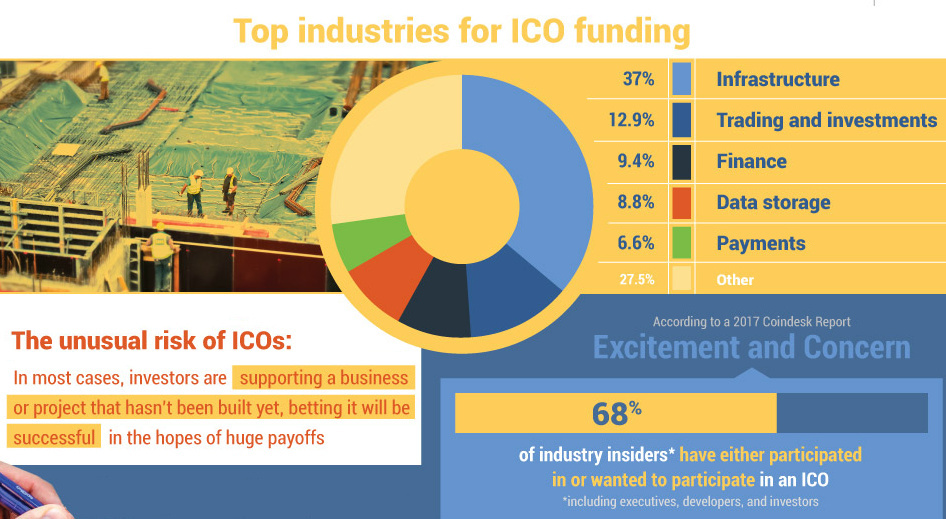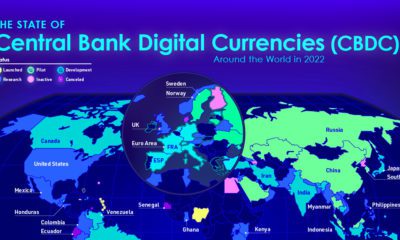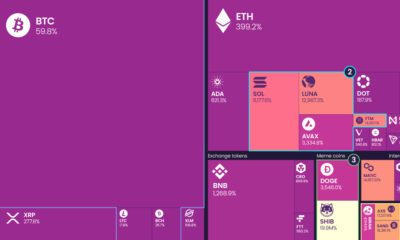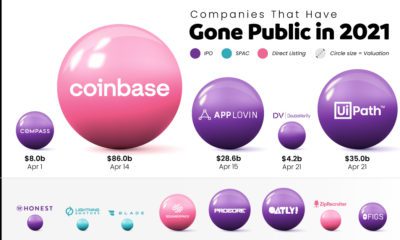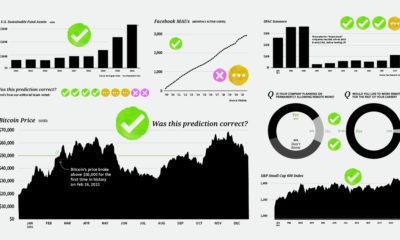That’s because IPOs have been around for centuries, they’re heavily regulated, and they usually are reserved for companies with impressive traction as they transition to the public market through a storied exchange like the NYSE or Nasdaq. During times of extreme market froth, like the Dotcom bubble, a newly public company can be the subject of intense amounts of speculation. However, in relative terms, most IPOs are fairly benign. Companies going public simply have a very abbreviated track record, which makes them difficult to value by the market.
Introducing the ICO
Today’s infographic comes to us from Coinlist, and it showcases the long-lost cousin of the IPO: the initial coin offering (ICO). At the most basic level, an ICO is a crowdfunded offering of a newly issued cryptocurrency that can be used as a source of capital for startup companies. Investors buy these coins or tokens with legal tender or through the exchange of other cryptocurrencies such as Bitcoin or Ethereum. And ICOs have taken off – see the incredible video on the explosion in ICOs for yourself.
ICO vs. IPO
Here are some major differences between ICOs and IPOs. Risk For a newly-listed public company, the market has limited information to assess – but usually the company has some known traction: sales, revenue, growth, etc. New listings can still be risky, but most still have some intrinsic value, even if that is just an asset at book value. ICOs, on the other hand, are usually used to raise capital for a new idea or technology. Ethereum, which ICO’d in 2015, is a blockchain-based technology that focuses on enabling smart contracts and decentralized apps. While it wasn’t “proven” at the time of its ICO, Ethereum is now a wild success. The only problem: not all new technologies or ideas are proven, and some will certainly crash and burn. Further, some will even be scams. Thus, the level of potential risk with ICOs cannot be understated. Regulation Newly-listed companies are highly regulated, for better or worse. ICOs are not regulated, though the SEC has stated that it will treat ICOs as security offerings in some situations. Meanwhile, other countries like South Korea and China have banned ICOs altogether, at least temporarily. Democratization While early-stage venture capital and IPOs are traditionally much more difficult for the average person to get exposure to, anyone can buy into an ICO. In this sense, the ICO offers something similar to crowdfunding: the ability for projects to raise money from a strong community of regular people. This community-based approach can also enable non-profit ventures to succeed.
A Full List of Pros/Cons
For a much more in-depth list of the pros and cons of ICOs, this article by Outlier Ventures provides some fantastic insights. on The good news is that the Federal Reserve, U.S. Treasury, and Federal Deposit Insurance Corporation are taking action to restore confidence and take the appropriate measures to help provide stability in the market. With this in mind, the above infographic from New York Life Investments looks at the factors that impact bonds, how different types of bonds have historically performed across market environments, and the current bond market volatility in a broader context.
Bond Market Returns
Bonds had a historic year in 2022, posting one of the worst returns ever recorded. As interest rates rose at the fastest pace in 40 years, it pushed bond prices lower due to their inverse relationship. In a rare year, bonds dropped 13%.
Source: FactSet, 01/02/2023.
Bond prices are only one part of a bond’s total return—the other looks at the income a bond provides. As interest rates have increased in the last year, it has driven higher bond yields in 2023.
Source: YCharts, 3/20/2023.
With this recent performance in mind, let’s look at some other key factors that impact the bond market.
Factors Impacting Bond Markets
Interest rates play a central role in bond market dynamics. This is because they affect a bond’s price. When rates are rising, existing bonds with lower rates are less valuable and prices decline. When rates are dropping, existing bonds with higher rates are more valuable and their prices rise. In March, the Federal Reserve raised rates 25 basis points to fall within the 4.75%-5.00% range, a level not seen since September 2007. Here are projections for where the federal funds rate is headed in 2023:
Federal Reserve Projection*: 5.1% Economist Projections**: 5.3%
*Based on median estimates in the March summary of quarterly economic projections.**Projections based on March 10-15 Bloomberg economist survey. Together, interest rates and the macroenvironment can have a positive or negative effect on bonds.
Positive
Here are three variables that may affect bond prices in a positive direction:
Lower Inflation: Reduces likelihood of interest rate hikes. Lower Interest Rates: When rates are falling, bond prices are typically higher. Recession: Can prompt a cut in interest rates, boosting bond prices.
Negative
On the other hand, here are variables that may negatively impact bond prices:
Higher Inflation: Can increase the likelihood of the Federal Reserve to raise interest rates. Rising Interest Rates: Interest rate hikes lead bond prices to fall. Weaker Fundamentals: When a bond’s credit risk gets worse, its price can drop. Credit risk indicates the chance of a default, the risk of a bond issuer not making interest payments within a given time period.
Bonds have been impacted by these negative factors since inflation started rising in March 2021.
Fixed Income Opportunities
Below, we show the types of bonds that have had the best performance during rising rates and recessions.
Source: Derek Horstmeyer, George Mason University 12/3/2022. As we can see, U.S. ultrashort bonds performed the best during rising rates. Mortgage bonds outperformed during recessions, averaging 11.4% returns, but with higher volatility. U.S. long-term bonds had 7.7% average returns, the best across all market conditions. In fact, they were also a close second during recessions. When rates are rising, ultrashort bonds allow investors to capture higher rates when they mature, often with lower historical volatility.
A Closer Look at Bond Market Volatility
While bond market volatility has jumped this year, current dislocations may provide investment opportunities. Bond dislocations allow investors to buy at lower prices, factoring in that the fundamental quality of the bond remains strong. With this in mind, here are two areas of the bond market that may provide opportunities for investors:
Investment-Grade Corporate Bonds: Higher credit quality makes them potentially less vulnerable to increasing interest rates. Intermediate Bonds (2-10 Years): Allow investors to lock in higher rates.
Both types of bonds focus on quality and capturing higher yields when faced with challenging market conditions.
Finding the Upside
Much of the volatility seen in the banking sector was due to banks buying bonds during the pandemic—or even earlier—at a time when interest rates were historically low. Since then, rates have climbed considerably. Should rates moderate or stop increasing, this may present better market conditions for bonds. In this way, today’s steep discount in bond markets may present an attractive opportunity for price appreciation. At the same time, investors can potentially lock in strong yields as inflation may subside in the coming years ahead. Learn more about bond investing strategies with New York Life Investments.
